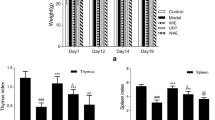Summary
Xiexin decoction (XXD), a classical pyretolytic formulation, is composed ofRhei rhizoma (DH)Radix scutellaria (HQ) andCoptis chinensis (HL), and commonly used in the clinical setting. The aim of this study was to investigate the pharmacokinetic differences between the five anthraquinones it contains (aloe-emodin, rhein, emodin, chrysophanol and physcion) in rats after the oral administration of XXD and after the administration of the different combinations of its constituent herbs. Twenty rats were divided into four groups and randomly administered one of the four extracts: DH, DH and HQ (DH-HQ), DH and HL (DH-HL), and XXD (DH-HQHL)via intragastric gavage (i.g.), Anthraquinone concentrations in the plasma were determined by an HPLC technique. Pharmacokinetic parameters were calculated from the plasma concentration time data. Compared with DH alone, the DH-HL combination showed maximum plasma concentration decreased (Cmax) and area under curve (AUC) for the values anthraquinones, and a prolonged eliminatun half life (T1/2) for rhein, while the DH-HQ combination showed a decrease Cmax for rein and a prolonged T1/2 for aloe-emodin and physcion. Finally, XXD (DH-HQ-HL) administration resulted in an increased AUC for all five anthraquinones compared to DH-HL, and increased the total of AUC for rhein, emodin, chrysophanol and physcion compared to DH alone. These results showed that the oral bioavailability of the five anthraquinones was significantly decreased by combining DH with HL, whereas HQ increased the amounts of absorbed anthraquinones (except for aloe-emodin), and weakened the effect of HL which inhibited the absorption of anthraquinones.
Similar content being viewed by others
References
Ma Y.-M., Yan J.-C., Wang T.-M., Shi R., Jiao Y.-B. (2006): Anti-inflammatory effects of Xiexin decoction on animal models of acute inflammation. Chin. Pharmacol. Bull., 22, 1393–1398.
Lo Y.-C., Tsai P.-L., Huang Y.B., Shen K.-P., Tsai Y.-H., Wu Y.-C., Lai Y.-H., Chen I.-J. (2005): San-Huang-XieXin-Tang reduces lipopolysaccharide-induced hypotension and inflammatory mediators. J. Ethnopharmacol., 96, 99–106.
Li J.-R., Zhang G.-P., Wu L.-S., Yan M-Z., Song H.-Y. (2004): Pharmacodynamic study on the sediments that produced by matching of herbs in Xiexintang. Chin. J. Exp. Trad. Med. Formul., 10, 27–30.
Liu B.-L., Xuan Y.- Y., Wang X.-H., Liu X.-H. (2003): Pharmacodynamic study of Sanhuang Xiexin Tang for treatment of upper gastrointestinal hemorrhage. Pharmacol. Clin. Chin. Mat. Med., 19, 1–3.
Sanae F., Komatsu Y., Chisaki K., Kido T., Ishige A., Hayashi H. (2001): Effects of San’o-shasin-to and the constituent herbal medicines on theophylline-induced increase in arterial blood pressure of rats. Biol. Pharm. Bull., 24, 1137–1141.
Xue Y., Zhou T.-H., Wang X.-M. (1999): Studies on precipitate produced in preparation of complex prescription of Chinese medicines Xiexin Decoction by LC/MS/MS and RPHPLC. J. Drug Anal., 19, 224–228.
Wang Ch.-Ch., Huang Y.-J., Chen L.-G., Lee L.-Tz., Yang L.-L. (2002): Inducible nitric oxide synthase inhibitors of chinese herbs. III.Rheum palmatum. Planta Med., 68, 869–874.
Zhang Y.-Q., Liu J.-H., Hu H.-F. (2004): Effects of rhubarb on nitric oxide and malondialdehyde in mice with endotoxemia. Chin. J. TCM WM Crit. Care, 11, 123–125.
Subhalakshmi B., Abhijit G., Banasri H. (2005): Evaluation of the antibacterial activity ofVentilago madraspatana Gaertn.,Rubia cordifolia Linn. andLantana camara Linn.: isolation of emodin and physcion as active antibacterial agents. Phytother. Res., 19, 888–894.
Guo M.-Z., Li X.-SH., Xu H.-R., Mei Zh.-Ch., Shen W., Ye X.-F. (2002): Rhein inhibits liver fibrosis induced by carbon tetrachloride in rats. Acta Pharmacol. Sin., 8, 739–744.
Meng K.-W., Yi L.-V., Yu L., Wu Sh.-L., Pan Ch.-E. (2005): Effects of emodin and double blood supplies on liver regeneration of reduced size graft liver in rat model. World J. Gastroenterol., 11, 2941–2944.
Wu Zh.-Ch.: Wu K., Wang H., Wang J. (2003): Experimental study on anti-atherosclerosis of Xiexin decoction in rats. Chin. J. Gerontol., 23, 461–471.
Ren J. (1996): Zhongguolidaimingyimingfangquanshu. Beijing: Academy Press: 35.
Author information
Authors and Affiliations
Rights and permissions
About this article
Cite this article
Yani, DM., Ma, YM., Shi, R. et al. Anthraquinone pharmacokinetics in Xiexin decoction and the different combinations of its constituent herbs. Eur. J. Drug Metabol. Pharmacokinet. 33, 69–75 (2008). https://doi.org/10.1007/BF03191023
Received:
Issue Date:
DOI: https://doi.org/10.1007/BF03191023




